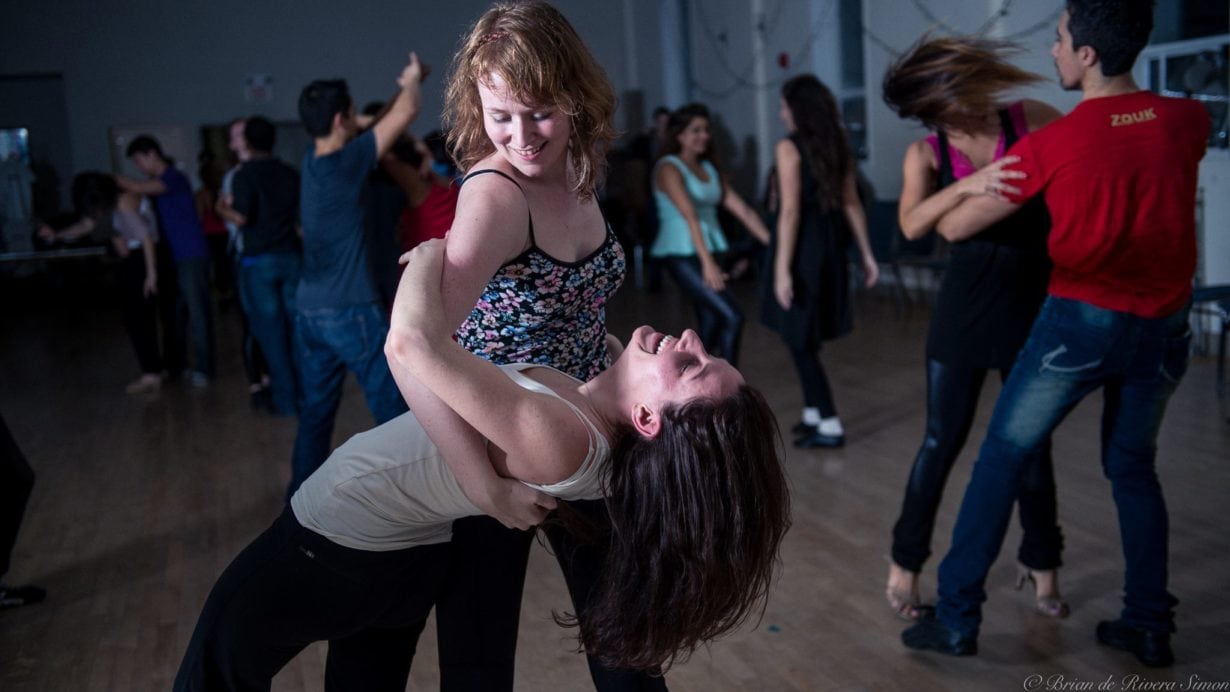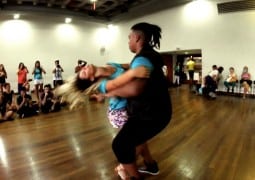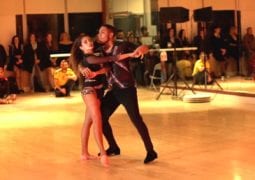Defensive Dancing – Zouk Safety Tips From Darius & Laura
Inspiration & Reflection
6,417 views

Darius Zi and Laura Riva finished off the 2015 Canada Zouk Congress (CZC) workshop program, Sunday night, with a much needed discussion on Zouk safety. We all know that Zouk can be extremely dangerous if not executed with the proper technique since this is a dance that involves an incredible amount of head movement, intricate arm combinations and cambre dips, requiring one to place their safety in another’s hands. For this reason, care should always be exercised and technique should be learned when attempting such moves.
Here are Darius and Laura’s “defensive dancing” tips that both leads and follows can use to make Zouking a safer experience:
Follows:
- Stretch your neck and warm the muscles before dancing to loosen up – always. Whether for class or social dancing, this is very important.
- Do not use your neck as a form of styling. Neck movement results when a lead signals for it. Injury can result if you throw your neck when you’re not positioned to do so. While there are some advanced dancers who can safely execute head styling, this takes years of training and understanding to do safely.
- Keep a relaxed neck. A lot of injuries result from tensing your neck and shoulders. Tension makes the muscles and tendons more sensitive to injury.
- Do not go into head movement “auto pilot.” Always be sensitive and listen to the lead as they can change the direction of your frame at any time.
- Exit head movement safely! When following a rotational head movement, only change direction when it is safe to do so. In other words, don’t sacrifice your safety to try to follow something that is dangerous.
- Always get your head back on top of your body by putting your body under your head. Trying to “pull” your head back on top by using the neck muscles can lead to injury.
- Reduce vulnerability by keeping your weight “on top of your body.” Do this by centering and holding your own balance. If a lead loses his balance, executes a rough lead or inadvertently drops you – you will want to be holding your own weight!
- When following a cambre (a dip-like movement), bend from the knees, not overcompensating with the lower back. Do not let your tailbone extend beyond your heels. You should feel the burn in your thigh and ab muscles, not your back muscles.
- It is harder to do a cambre bend with feet and heels together. Try to keep one foot slightly behind the other to increase stability and balance.
- If a lead takes you off of your center, walk your feet so can resume balance.
- You are never obligated to follow something that is uncomfortable, beyond your skill, or that you simply don’t want to do. Respect your fitness and flexibility, as well as any injuries you may have. Head movements, cambres, and other movements can all be done safely with limited flexibility and athleticism. Do these things to the degree that is right for you.
Leads:
- Lead head movement by gently tilting your follow’s frame. It does not require a tremendous amount of force. Never force the head movement, or any lead for that matter. If she doesn’t follow or doesn’t bend as much as you hoped, that’s ok. Move on and do something else.
- If your partner is engaged in head movement, do not change to a move that would work against that flow and potentially result in an unsafe change of direction (even if she’s backleading). This can cause whiplash. Let her finish the movement, then decide what to do next.
- Only change direction when the upper body rotation is on the side AND has passed through the front. Changing direction when the head is extended backward or moving from the back can result in injury by straining the neck muscles.
- Never lead a follows neck backward without rotating through the side first – this can cause whiplash!
- Leave time for your partner to catch up if she is late. Even if it puts you off time, wait for her first. This applies to any movement. Being there for your partner should be your first priority.
- Always cambre a partner over her center of balance. It is NOT a Salsa dip. The direction is down, not to the side, in a dip.
- Go slow. Test her limits before you go all out. Do a small dip, simple head movement, etc. at a slow speed first. If she follows this, add a little more speed or difficulty.
For both:
- Be aware of your surroundings and partner. Look for potential collisions before you start a movement.
- Be aware of your partner’s limitations. Are they drunk? Tired? Injured? A beginner? Are they warmed up yet? Test the limits first, even if you know the partner. Use your judgment in what will be safe to lead/follow.
- If body language doesn’t seem to be getting the point across and someone is endangering your health or safety (especially as a follow), you are allowed to mention it. Say something like; “I’m just not comfortable doing that right now” to take the pressure off of making them feel like they did something “bad.”
DISCLAIMER: These tip are for reference only and are not guaranteed to prevent injury. Like any physical activity, zouk has risks. It is always better to work in person with a trusted instructor on your technique and safety.
Photo credit: © Brian de Rivera Simon Tarsipix Studios – http://www.tarsipixstudios.com/
About: Danielle Marie
- Previous Marie Alonzo Snyder’s Impressions of Artistry in Zouk & Kizomba Choreography
- Next Video: NYC ZOUKnami caught on Camera!
You may also like...
Sorry - Comments are closed







